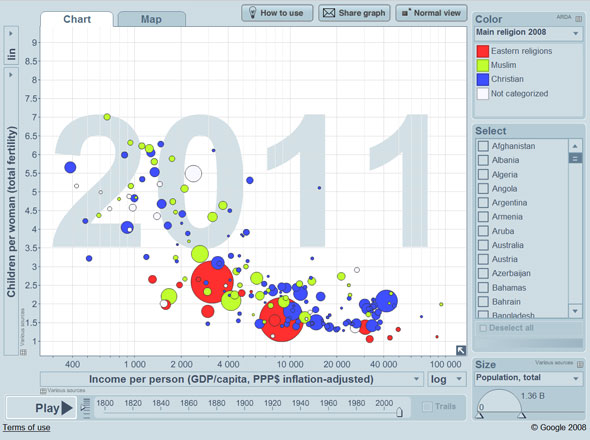-
Hans Rosling on Religion, Babies, and Poverty
August 17, 2012 By Carolyn Lamere“I’m going to talk about religion. But it’s a broad and very delicate subject, so I have to limit myself. Therefore I will limit myself to only talk about the links between religion and sexuality…I will talk on what I remember as the most wonderful – it’s the moment when the young couple whispers, ‘tonight, we are going to make a baby,’” said Hans Rosling, the eclectic Swedish doctor and statistician known for his Gapminder tool, in a TedxSummit presentation in April.
In the past, Rosling has presented on topics ranging from human rights to washing machines. This time, in Doha, Qatar, he tackled the number of babies a woman will have in her lifetime, also known as total fertility rate (TFR). He tracks this figure, by country, along with average income and basic religion type, from 1960 to 2011.The results are intriguing.
Remarkable Progress
First, Rosling points out that humanity as a whole has experienced a rapid drop in the fertility rate over the past 50 years. “By 2010, we are actually 80 percent of humans who live in countries with about two children per woman,” he notes.
Even countries whose fertility rates seem to have stagnated more recently have experienced this “tremendous improvement.” Rosling highlights Ghana and Senegal, which have reduced their fertility rates from over seven in 1960 to between four and five today.
Rosling also notes that fertility has fallen “across the world,” even in lower income countries. For example, although Vietnam has less than five percent of the GDP of the United States, their TFR is comparable.
But high fertility remains in some poorer countries, like the Democratic Republic of the Congo (5.7, according to Gapminder) and Afghanistan (6.6). And although these countries have relatively high mortality rates, they are still projected to double their populations in 30 years. “In the world today, it’s the countries that have the highest mortality rate that have the fastest population growth because the death of a child is compensated by one more child,” says Rosling.

Religion and Fertility
Rosling also classified each country by the basic type of religion held by the majority of its inhabitants – Christianity, Islam, or “eastern religions,” which include Hinduism and Buddhism. “In 1960, you had to be a rich Christian to have few babies,” Rosling says. “The exception was Japan,” which had a fertility rate of two children per woman in 1960.Over time, however, fertility rates fell across the board. Now, “there’s no major difference” in the fertility rate of Islamic and Christian countries; countries of each religion experience high and low fertility rates. (Countries with “eastern religions” all currently have fairly low fertility rates; the highest, Nepal, has a TFR of 2.7.)
Rosling posits that the real barriers to reducing fertility are four-fold: “children should survive, children shouldn’t be needed for work, women should get education and join the labor force, and family planning should be accessible.”
“All the religions of the world are fully capable to maintain their values and adapt to this new world,” he says.
Intuitively, however, this isn’t exactly the full story. Rosling’s three very broad categories for religion obscure a great many differences between different sects and factions, and in some countries, religion is tied directly to those barriers he mentions.
In the Philippines, for example, the Catholic Church has been a major part of opposition to more and better access to contraceptives. Other countries, like Yemen, Afghanistan, and Liberia, face deep divides over women’s role in society, with very early marriage making it difficult for women to get an education and enter the labor force. Thus while there are countries of all religions which accept the use of modern contraceptives, for others, religion remains a very real obstacle to reducing fertility rates.
“Peak Child”
Nonetheless, Rosling is right when he says, “we have reached peak child” – at least if the UN Population Division’s medium variant projections are to be believed (there are also high and low variants). The number of babies being born around the world will likely never be higher than it is now. Yet world population is expected to continue to grow throughout the rest of the century. The UN medium variant projection for 2100 is 10 billion people. Rosling explains that total world population will increase despite the number of children in the world remaining fairly constant this century because younger generations are larger than older generations.
“You can see it’s like there are three [billion] missing here,” he says, referring to an illustration of global population created by stacking boxes. “They’re not missing because they’ve died – they were never born. Because before 1980 there were much fewer people born than there were during the last 30 years.” As the smaller, older generations age, they will be replaced by younger, larger generations, a trend known as population momentum. “This is the great fill-up, it’s inevitable.”
Although a large portion of future population growth is thus inevitable, the pace of fertility decline in those areas where it is still high is not. This creates the uncertainty in projections like those made by the United Nations. It’s also an impetus for countries and the international community to continue to break down Rosling’s four barriers.
“We will be just 10 billion in this world if the poorest people get out of poverty, their children survive, they get access to family planning – that is needed,” he stresses. “This is indeed important because everyone understands that there is some sort of limit on how many people we can be on this planet.”
Sources: Gapminder, TED, UN World Population Division.
Video Credit: Hans Rosling: Religions and Babies, courtesy of TED. Image: Gapminder World.
Topics: demography, Eye On, family planning, gender, global health, population, poverty, religion, video, youth
 A Publication of the Stimson Center.
A Publication of the Stimson Center.



